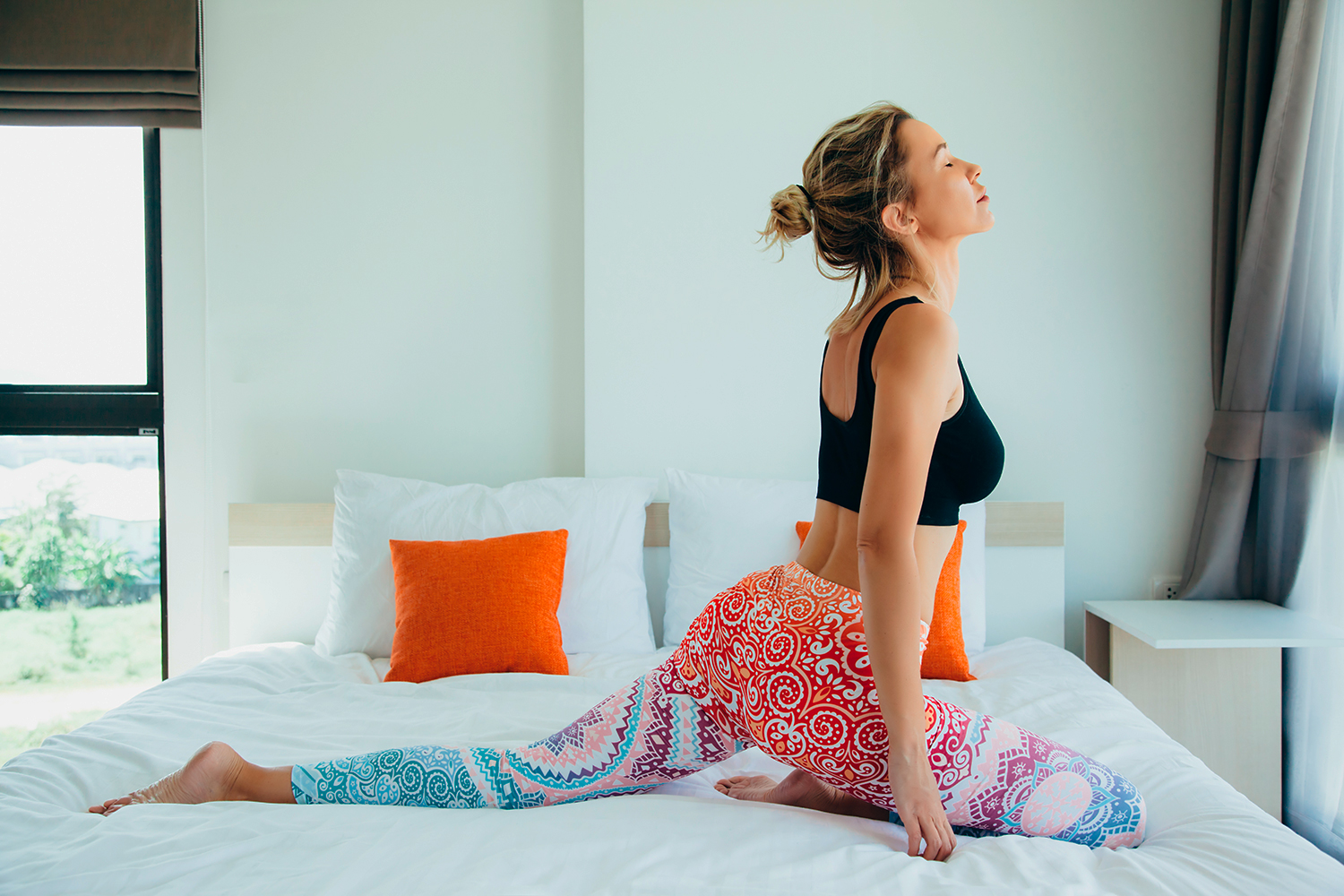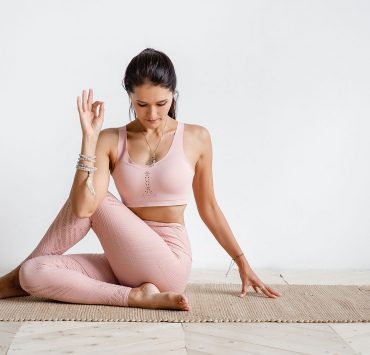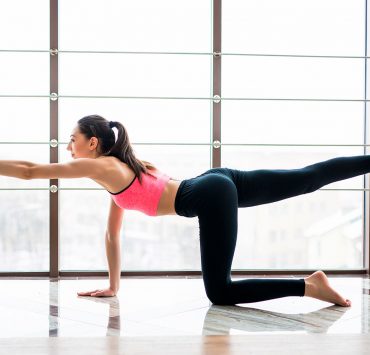
A graduate of Arizona State University, Nicole Baker is a…
Yoga is best practiced daily, even if it’s not a full 60 or 75-minute practice. Studies have shown that a consistent yoga practice can reverse DNA reactions that cause stress, lower basal metabolic rate, improve body weight, lower blood pressure, assist with cholesterol levels, improve sleep quality, create a positive impact on mood, reduce pain levels, and create an opportunity for self-reflection and discovery. In a national study conducted by researchers from the University of Maryland School of Nursing and the National Institutes of Health Clinical Center, the frequency of a home practice is extremely important, even more important than how long an individual has been practicing or how many classes they take.
While practicing sun salutations in the morning is highly recommended and feels great for the body, it’s not always practical. As opposed to skipping a daily yoga practice because it may too long, too sweaty, or too rigorous, we’ve compiled a list of yoga postures to easily do on or near the bed to help people get the most out of their yoga practice in the morning.
Apanasana — Knees to Chest Pose

Knees to chest helps digestion, improve flexibility in the lower back, drawn awareness inwards, and help with menstruation or gas. Start by laying on the back in bed and let the back of the head and shoulders press firmly on the downwards. A pillow can be placed underneath the head if the neck needs more support. Bring the knees towards the chest and wrap the arms around the shins. For an easier modification, a yoga strap or belt can be placed around the shins. For more challenging modification, try to hug opposite elbows. Hold this posture for a minimum of 10 breaths.
Bananasana — Banana Pose

Banana helps stretch the whole side of the body, assist with lateral flexion of the spine, stretches the obliques, and even stretches the armpits! Lie on the back with legs together and reach the arms behind the body. Keep the glutes firmly rooted into the mattress and arch the body to the right by reaching the legs and arms to the side like a banana. Be careful not to lift the arms off the bed or roll onto the side body, the entire backside of the body stays on the mattress. Spend at least 10 breaths on each side. If the body feels like it can stretch further after a few breaths, move the legs and arms even further.
Supta Baddha Konasana — Reclining Bound Angle Pose

Reclining bound angle pose benefits the body by stretching the inner thighs, groin, and knees. It can help relieve stress, mild depression, menstruation, and menopause; as well as stimulating the heart and abdominal organs. To start, lie on the back. The back of the head is pressed into the mat while the chin gently bows toward the chest. Plant the feet together close towards the glutes. Begin to rotate both thighs outward as the soles of the feet come together. If the grown or the inner thighs are tight, place bolsters or pillows on underneath the outsides of the thighs for support. Hold for 8 breaths or longer.
Jathara Parivartanasana — Reclined Abdominal Twists Pose

According to Amy Matthews, co-author of Yoga Anatomy, twists affects mobility and motility within the body. In terms of mobility, the movement of the organs with each other and for motility, movement within the organ. Reclined twists also stimulate circulation, builds heats in the body, releases tension along the spine, and increases the mobility of the abdomen.
Lie on the back and reach the arms out to the side in a T with the palms facing up. Bring the knees towards the chest. Keep the knees and ankles together. Release the knees to the left-hand side of the bed while trying to keep the ankles aligned with the knees. Take the gaze towards the right hand. Keep both shoulders onto the mattress. If the legs cannot lower all the way down to the bed, place a blanket or pillows underneath the legs for support. If the shoulders begin to lift place a small pillow or cushioning underneath the raised shoulder. Repeat on the other side, with a minimum of 10 breaths on each side.
Dandasana — Staff Pose

Although it may look like one is just sitting, when practiced with correct alignment and engagement in the body, staff pose improves back health, increases stamina, strengthens the core, and assists with posture.
Start by sitting on the bed with the legs extended. Lift the fleshy parts of the buttocks away from the sitz bones so the body feels more grounded and there is a more solid base. Rotate the thighs towards each other so the knees face towards the ceiling. Create a gentle flex in the feet and actively press the heels downward. Become mindful of the pelvis. There should be a slight tilt forward as opposed to rounded back into the tailbone. If this is challenging, it could be helpful to sit on the edge of a pillow to naturally lift the pelvis to assist with the forward tilt. Elongate the spine, engage the abdominals, and place the hands on the mattress underneath the shoulders. Hold for a minimum of 5 breaths.
Paschimottanasana — Seated Forward Bend Pose

Seated forward bends when practiced correctly helps relieve stress, improve digestion, reduces fatigue, and stimulate internal organs around the belly. It also stretches the back, shoulders, and hamstrings.
From staff pose, place the hands on the hips to bring awareness there. Lean forward from the hips while lengthening the tailbone away from the pelvis. Keep the belly in and the spine elongated. The hands can either release to the side of the legs or a strap or belt can be placed around the feet and grab onto the sides of the strap. Shoulders should remain back and elbows in. Ensure the legs and heels stay grounded into the mat. Hold for a minimum of 5 breaths.
Balasana — Child’s Pose

Child’s post a resting pose that gently stretches the spine, assists in digestion, mentally soothing, and can help relieve back and neck pain when the head has support. Start with the hands and knees on the mattress and let the feet touch while the knees out further towards the side. Let try to bring the glutes towards the heels then extend the arms forward. Let the spine extend, lengthen the neck and place the forehead on the mattress or a small pillow. Spend a minimum of 10 breaths in this posture. Practitioners can also bring the knees together for a more intense stretch.
Marjaryasana and Bitilasana — Cat/Cow Pose

Cat cow is a combination of two poses often practiced together. Together cat cow helps stretch the torso and neck, stimulate the spine and belly organs as well as opening the torso and the neck.
Start in table top, by coming onto the hands and knees. Let the wrists come underneath the shoulder and distribute the weight evenly through the hands. The knees are hip distance apart with the feet in line with the knees. The tops of the feet may rest on the bed. The gaze is down in between the hands Start with cow pose. On an inhale, release the belly down while the chest lifts and sitz bones reach towards the ceiling. The gaze goes forward. On the exhale, come into cat pose by bringing the chin towards the chest as the spine rounds towards the ceiling and the tailbone begins to tuck under. Complete a minimum of 8 rounds of breath, alternating between cat and cow.
Parsva Balasana — Thread the Needle Pose

Also known as revolved child’s pose, thread the needle helps stretch the shoulders and the chest while calming the body.
To start, come into table top. On an inhale, root in through right hand and extend the left arm up towards the ceiling and reach through the fingertips. On the exhale, release the left arm across the chest and let the left shoulder and cheek release onto the bed. Extend the right arm forward. Other modifications for the arm include placing the top of the right hand on the small of the back or reaching for the left thigh while rotating the chest towards the sky. Hold for a minimum of 8 breaths. To come out of the posture, place the right hand on the bed underneath the right shoulder and rise up. Repeat on the opposite side for the same amount of breaths.
Tadasana — Mountain Pose

Like staff pose, mountain pose is more complex than it looks. As opposed to simply “standing there” mountain pose requires balance, alignment, and awareness of the body. For those who are skeptical, jump up and down on the floor then close the eyes and notice how the body feels. Then use the steps below to practice mountain pose and compare how the body feels– there will be a huge difference. Mountain pose helps improve posture, strengthen the legs and back, tones the belly and glutes, and is the foundational posture for all standing postures.
To come into mountain pose, place the feet on the floor either together or hip distance apart. Rotate the toes so they are facing forward with the heels behind the toes. For some people, this can aggravate their knees or hips so if it feels better, feet may be able to slightly rotate inwards or outwards depending on their skeletal variation. Activate the legs so pressure feels lifted off the knees. Let the pelvis remain neutral. Lift through the rib cage and lengthen the spine. Let the shoulders blades release down. The arms will calm along the side body while rotating the palms forwards. Lengthen down through the arms down towards the fingertips. Lift through the crown of the head while staying rooted through the feet. Soften the gaze. Notice the strength of the posture. Maintain this posture for a minimum of 10 breaths.
Urdhva Hastasana — Upward Salute Pose

Upward salute is more than just bringing the arms over the head. When practiced properly it “teaches extension from the ground up, lengthens the side waist, strengthens arms and shoulders.”
To start, come into mountain pose. Rotate the palms out to the sides and on inhale bring up towards the sky. Internally rotate the arms by keeping the arms a few inches away from the ears with the elbows and hands shoulder distance apart. Exhale and ground deeper into the feet. On the inhale and lift up through the rib cage. The shoulders blades come down while the arms continue to extend up. Hold for a minimum of 5 breaths.
Anuvittasana — Standing Back Bend Pose

Standing backbends can help improve posture, open the chest, and strengthen the respiratory, cardiovascular, and endocrine systems.
To begin come into mountain pose. Continue to feel grounded from the waist down. Reach the arms up and come into upward salute. Engage the abdominals. On the exhale lift the heart and bend the upper back and slightly release the next back to open the throat. Take 2 to 3 breaths in this pose.
Uttanasana — Standing Forward Bend Pose

Standing forward bend not only stretches the hamstrings, calves, and hips but also helps deepen the breath. Additionally, it can help some by reducing fatigue and anxiety and improve digestion.
Start in mountain pose. On an exhale, hinge forward and the hips while tilting the pelvis forward. The legs can stay straight or slightly bent, hamstring or lower back is tight. Keep the spine elongated all the way through the neck. Bring the hands towards the floor or any object on the floor, such as a block or a book, if the hands cannot reach all the way down. Keep the weight centered in the middle of the feet and continue to hinge forward and the hips until a slight stretch is felt in the hamstrings. Hold for a minimum of 4 breaths.
Utthita Hasta Padangusthasana Variation — Standing Knee to Chest Pose

Standing knee to chest is the preparatory posture for standing hand to big to pose and is excellent for a morning practice that is not too intense but can still awaken the body. This balancing posture helps to strengthen the thighs, calves, ankles while stretching the hips, hamstring, lumbar spine, and psoas. Additionally, the posture aids in digestion and decreases inflammation.
Start in mountain pose and place a little more weight in the right foot. Find a focal point to gaze at. Keep the foundation of the posture and gradually lift the left knee as high as possible without losing the integrity of the pose on an inhale. Place the arms around the shin and on the next inhale try to lift the leg a little higher. If the hands cannot reach the shin, place a strap or belt around the shin to hold the leg. Keep the elbows in. Hold the posture for 4 breaths or more and repeat on the other side.
Mindful Meditation to end the practice

To end the morning yoga practice, a mindful seated meditation can help integrate the practice. By practicing mindful meditations, practitioners can learn how to understand their pain, improve interpersonal relationships, decrease stress, focus the mind, and reduce rumination of the mind.
Start by sitting on the edge of the bed with the feet on the floor. Set a timer between 3 to 5 minutes. Close the eyes. Beginning to draw the awareness inwards and notice how the body feels. There is no need to praise or judge the body, just notice the subtleness of the body. For instance, observe how at ease or tight it feels, notice how the body makes contact with the bed or the floor. Observe the breath. Witness how the body moves with the breath. Continue to make observations of the body and breath until the practice is complete.
Conclusion
Yoga has been known to improve health. By starting each morning with a short but effective gentle yoga practice, practitioners can develop positive habits to improve their physical, mental, and emotional state of mind for just 10 to 20 minutes a day worth of practice.

What's Your Reaction?
A graduate of Arizona State University, Nicole Baker is a force to be reckoned with in the realm of health and wellness. She studied behavioral health, which propelled her desire to live holistically and share her knowledge with other like-minded individuals.














